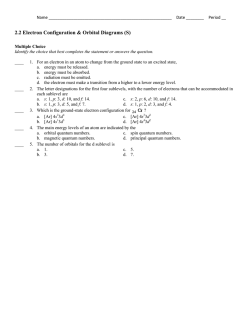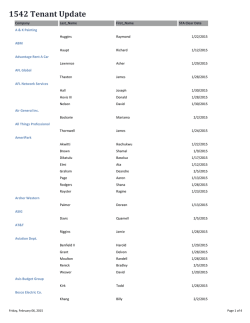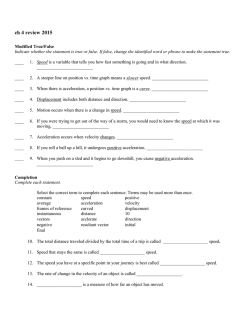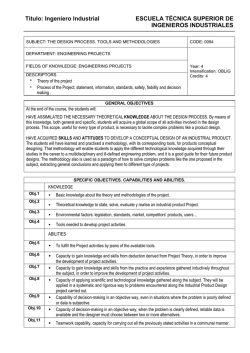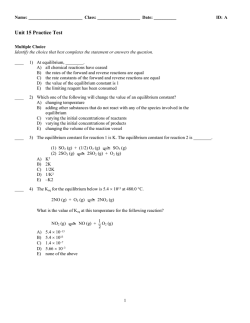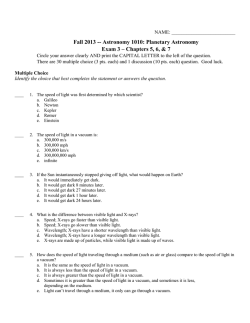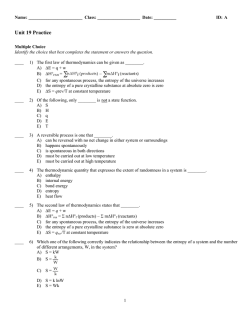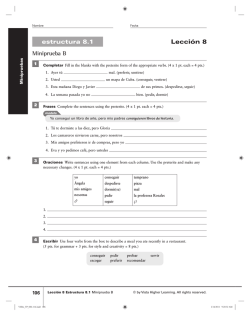
File
Name: ________________________ Class: ___________________ Date: __________ Industrialization Practice Test Multiple Choice Identify the choice that best completes the statement or answers the question. ____ 1. What contribution did Henry Bessemer make to the steel industry? a. He developed a way to make steel quickly and cheaply. b. He developed a tougher and more durable type of steel. c. He developed a way to produce steel without the use of heat. d. He developed a way to make steel without polluting the air. ____ 2. New technologies in the steel industry in the late 1800s led to increased productivity in the a. textile industry. b. railroad industry. c. oil industry. d. electricity industry. 3. What was the main effect of the expansion of railroads across the United States? a. rapid growth of cities b. increase in the price of steel c. decrease in interstate trade d. movement of city dwellers to the suburbs ____ ____ 4. Thomas Edison described himself as a a. “passionate businessman.” b. “professional inventor.” c. “pure scientist.” d. “social Darwinist.” ____ 5. Thomas Edison invented the a. telegraph. b. telephone. c. light bulb. d. automobile. ____ 6. Which of the following statements about Thomas Edison is true? a. Edison did not hold patents on any of his inventions. b. Edison built systems that mainly powered centralized cities. c. Edison developed a way to send electricity over miles of wires. d. Edison designed a trolley car that could run without a cable. ____ 7. Who invented the telephone? a. Alexander Graham Bell b. Thomas Edison c. Orville Wright d. Henry Bessemer 1 ID: A Name: ________________________ ID: A ____ 8. The first lightweight airplane invented by Wilbur and Orville Wright was powered by a. coal. b. wind. c. gas. d. steam. ____ 9. The invention of the airplane led to increased demand for which natural resource? a. aluminum b. lumber c. coal d. oil ____ 10. How did the telegraph differ from the telephone? a. The telegraph could work only in big cities. b. The telegraph was much more expensive than the telephone. c. The telegraph could carry only coded messages. d. The telegraph could not send messages over long distances. ____ 11. What effect did the moving assembly line, introduced by Henry Ford, have on the automobile ____ 12. ____ 13. ____ 14. ____ 15. industry? a. It reduced profits. b. It made cars safer. c. It decreased the cost of production. d. It improved working conditions in factories. Which of the following is true about stockholders? a. They must pay the corporation's debts. b. They can sell their stock shares at any time. c. They are responsible for the corporation’s policies. d. They vote directly for the corporation's president. Andrew Carnegie managed to keep production costs for his steel mills low by a. applying for government loans and taking advantage of corporate tax breaks. b. using assembly lines and other advanced manufacturing methods. c. purchasing machinery to produce steel instead of hiring workers. d. owning the businesses involved in each step of the manufacturing of steel. Leland Stanford believed that industries should a. allow large corporations to obtain monopolies. b. be owned and managed by one person. c. be owned and managed cooperatively by the workers. d. join together to increase business. Of which of these practices would entrepreneur John D. Rockefeller have approved? a. purchasing all of the businesses in a single field to control production b. promoting competition between companies to improve quality c. letting the government monitor and manage business deals d. providing different boards of directors for every branch of a business 2 Name: ________________________ ID: A ____ 16. Vertical and horizontal integration were strategies designed to a. end unsafe working conditions and promote cooperatively run corporations. b. eliminate competition and control every step of the production process. c. encourage existing stockholders to purchase more shares. d. give stockholders control over corporations. ____ 17. Social Darwinism is the idea that a. business is becoming less and less human. b. only the fittest individuals succeed in society. c. successful businessmen must aid the poor. d. all men should share the profits of business. ____ 18. Which of the following is an example of vertical integration in the movie business? a. owning the majority of the movie theaters in the country and around the world b. acquiring the studios, theaters, and TV stations involved in making and distributing movies arguing that the industry should be owned by actors, directors, producers, and studio executives alike d. justifying business methods on the grounds that those naturally inclined to succeed will survive in the industry ____ 19. The Sherman Antitrust Act was a law passed by the Congress in 1890 that a. allowed businesses to charge more than market value for a particular product. b. protected the rights of laborers working for large corporations. c. allowed corporations to force competitors out of business. d. prevented any corporation from creating a monopoly. ____ 20. How did the Sherman Antitrust Act affect big businesses in America? a. The act was difficult to enforce, so big business continued to grow in America. b. The act declared monopolies illegal, which allowed smaller businesses to prosper and grow. c. The act forced big businesses to improve working conditions for their laborers. d. The act satisfied the concerns of the voters about the growth of big business in America. c. 3 Name: ________________________ ID: A ____ 21. Study the political cartoon below and answer the question that follows. What does the cartoon illustrate? a. Rockefeller’s monopoly over the oil industry in America b. the struggle between big business and the government c. Rockefeller’s financial control of the government d. the government’s attempt to regulate big business ____ 22. Monopolies were criticized as unfair because they a. illegally restrain international trade. b. give too much political power to the president of the corporation. c. raise the prices and reduce the quality of specific products. d. prevent stockholders from controlling a corporation’s policies. ____ 23. How did the labor force change during the Second Industrial Revolution? a. Skilled craftspeople were replaced with unskilled machine operators. b. Industries began to hire highly educated workers. c. Workers began to receive health benefits and better wages. d. Experienced workers replaced children who had been working in industries. ____ 24. The decline in working conditions in American industries in the late 1800s occurred because of the a. drive to regulate monopolies. b. weakening of labor unions. c. emphasis on high profits and efficiency. d. abolition of health benefits. 4 Name: ________________________ ID: A ____ 25. Who encouraged managers to view workers as interchangeable parts, and why? a. Terence V. Powderly, to create employment opportunities for all union members b. Frederick W. Taylor, to increase efficiency and worker productivity in factories c. Henry Ford, to speed automobile production and make cars more widely available d. Andrew Carnegie, to encourage firing disruptive workers and hiring compliant ____ 26. ____ 27. ____ 28. ____ 29. ____ 30. ____ 31. ones Which of the following was an effect of factory specialization in the late 1800s? a. Workers repeated the same step over and over again, becoming tired, bored, and more likely to be injured. b. Factories produced only a single product, putting owners at greater financial risk if that product failed. c. Unions signed contracts with specific factories, eliminating violent conflicts over wages and working hours. d. Managers paid more attention to working conditions, attracting workers and creating greater competition for jobs. Why did labor unions form? a. Immigrants did not want to compete with natives for jobs. b. Women wanted equal treatment in the workplace. c. Workers needed to increase their bargaining power. d. Factory managers would only hire union labor. What does Mary Harris Jones symbolize? a. the importance of Irish immigrant labor b. the difficulty miners had in organizing a union c. the desire of mothers to end child labor d. the active role women played in unions For which of these improvements did the Knights of Labor fight? a. equal rights for workers of all races b. an eight-hour workday c. government regulation of child labor d. higher wages for unskilled workers How was the Knights of Labor organization different from the American Federation of Labor? a. The Knights of Labor fought for the end of child labor. b. The Knights of Labor accepted skilled and unskilled workers. c. The Knights of Labor accepted women as members. d. The Knights of Labor were ruled by highly skilled workers. How did Terence V. Powderly change the Knights of Labor in 1879? a. He persuaded the group to join the AFL. b. He ended the secrecy of the union. c. He accepted unskilled members into the union. d. He organized smaller, more specialized unions. 5 Name: ________________________ ID: A ____ 32. What was Samuel Gompers’ role in the labor movement? a. He organized the Pullman Strike. b. He founded the Knights of Labor. c. He was the president of the American Federation of Labor. d. He was the chairman of the American Railway Union. ____ 33. Collective bargaining is the a. practice used by employers to find large groups of laborers. b. practice used by employers to get the cheapest labor possible. c. idea that laborers working in groups are more productive in the workplace. d. idea that laborers acting together as a group could improve working conditions. ____ 34. Study the quotation below and answer the question that follows. “. . . the introduction of machinery is turning into idleness [joblessness] thousands . . . and yet, machinery certainly should not be either destroyed or hampered in its full development . . . The laborers must learn to think and act, and soon, too, that only by the power of organization, and common concert of action, can . . . their rights to life be recognized, and liberty and rights secured.” —Samuel Gompers, from his “Letter on Labor in Industrial Society to Judge Peter Grosscup,” September 1894 The reader of this passage can conclude that Samuel Gompers believed that a. machinery made laborers more productive and safer in the workplace. b. laborers would not be able to negotiate for better wages without joining a union. c. the use of machinery in industries should be banned. d. laborers should band together to improve working conditions. ____ 35. The government responded to the Homestead and Pullman Strikes in the late 1800s by a. ignoring the conflicts between strikers and business owners. b. sending in federal troops to break up the strikes. c. forcing big business owners to raise the workers’ pay. d. passing legislation that made working in factories safer. ____ 36. Which event led to the weakening of the Knights of Labor? a. the Steelworkers’ Strike b. the Homestead Strike c. the Haymarket Riot d. the Pullman Strikes ____ 37. The Homestead Strike was a protest a. in Colorado demanding safer working conditions. b. in Chicago demanding an eight-hour workday. c. against the Pullman Palace Car Company to improve working conditions. d. against the Carnegie Steel Company to force the company not to cut jobs. 6 Name: ________________________ ID: A ____ 38. What were union members fighting for at the strike that led to the Haymarket Riot? a. an eight-hour workday b. higher wages c. a ban on new machinery d. lower rents ____ 39. Andrew Carnegie dealt with the striking union workers at his Pennsylvania steel factory in 1892 by a. firing every worker and replacing them with machines. b. firing half the workers and cutting pay for the remainder. c. locking workers out of the factory and hiring strike breakers. d. hiring guards to lock workers out of the plant. ____ 40. Study the chart below and answer the question that follows. According to this chart, which of the following statements is true? a. The Haymarket Riot severely damaged the AFL. b. The Pullman Strike attracted new members to the American Railway Union. c. Until the late 1880s, the Knights of Labor was steadily losing members. d. The AFL more than doubled its membership in the last years of the 1800s. Completion Complete each statement. 41. Steel production in the United States jumped from less than 100,000 tons a year in 1870 to more than one million tons a year in 1879. This improvement was due in large part to the invention of the ______________________. (assembly line/Bessemer process) 7 Name: ________________________ ID: A 42. The telephone is the most well-known of ______________________________’s inventions. (Alexander Graham Bell/Thomas Edison) 43. Wilbur and Orville Wright built a lightweight airplane that ran on a _______-powered engine. They made their first piloted flight in _____________, North Carolina on December 17, 1903. (steam, Raleigh/gas, Kitty Hawk) 44. Henry Ford’s idea of the _________________________ made the process of constructing automobiles faster and cheaper. (assembly line/collective bargaining) 45. _________________ own a corporation, but they do not make its day-to-day business decisions. (CEOs/Stockholders) 46. Standard Oil developed _________________ integration by buying nearly all other businesses in its field. (horizontal/vertical) 47. The belief known as ____________________________ said that the “fittest” people would succeed in business and in their lives. (social Darwinism/natural selection) 48. Terence V. Powderly became leader of the ____________________________ in 1879 and created the first truly national labor union in the United States. (American Railway Union/Knights of Labor) 49. The _______________________ was a protest against the Carnegie Steel Company. (Pullman Strike/Homestead Strike) 50. At a protest in Chicago’s __________________________, a bomb killed eight police officers and injured many others. (Haymarket Square/Lincoln Square) True/False Indicate whether the statement is true or false. ____ 51. The Bessemer process sped up the procedure of refining oil. ____ 52. Thomas Edison developed a power system that could send electricity over long distances. ____ 53. A corporation’s stockholders are responsible for helping the corporation pay its business debts. ____ 54. Andrew Carnegie succeeded because he owned businesses that were involved in each step of the manufacturing process. The name for this strategy is horizontal integration. ____ 55. Big business continued to grow in America despite the passage of the Sherman Antitrust Act, which was difficult to enforce. ____ 56. During the Second Industrial Revolution, skilled craftspeople were often replaced with unskilled workers who operated machinery. ____ 57. The Knights of Labor was unusual in that it included both skilled and unskilled workers. ____ 58. Samuel Gompers contributed to the labor movement by fighting for the rights of unskilled industrial workers. 8 Name: ________________________ ID: A ____ 59. George Pullman lowered rents in the Pullman Palace Car company town when he cut his workers’ pay. ____ 60. The governor of Pennsylvania called on the state militia to restore order after the Homestead strike. Matching Match each item with the correct statement below. a. corporations b. Frederick W. Taylor c. Bessemer process d. Andrew Carnegie e. Knights of Labor f. Thomas Edison g. horizontal integration h. Samuel Gompers i. Henry Ford j. social Darwinism k. Grover Cleveland l. Sherman Antitrust Act ____ ____ ____ ____ ____ ____ ____ ____ ____ ____ 61. 62. 63. 64. 65. 66. 67. 68. 69. 70. John D. Rockefeller’s control of about 90 percent of the oil refining business owned businesses involved in each step of the manufacturing process of his industry led the American Federation of Labor fought for the rights of skilled and unskilled workers made manufacturing more efficient with the moving assembly line inventor of the light bulb made it illegal to create monopolies made steel production quicker and cheaper, which created a booming railroad industry idea that those who were "fittest" would be successful encouraged managers to view workers as interchangeable parts of the production process 9 ID: A Industrialization Practice Test Answer Section MULTIPLE CHOICE 1. ANS: NAT: 2. ANS: NAT: 3. ANS: NAT: 4. ANS: NAT: 5. ANS: NAT: 6. ANS: NAT: 7. ANS: NAT: 8. ANS: NAT: 9. ANS: NAT: 10. ANS: NAT: 11. ANS: NAT: 12. ANS: NAT: 13. ANS: NAT: 14. ANS: NAT: 15. ANS: NAT: 16. ANS: NAT: 17. ANS: NAT: 18. ANS: NAT: 19. ANS: NAT: 20. ANS: NAT: A 19.1.1 B 19.1.1 A 19.1.2 B 19.1.2 C 19.1.2 B 19.1.2 A 19.1.3 C 19.1.3 D 19.1.3 C 19.1.3 C 19.1.3 B 19.2.1 D 19.2.1 C 19.2.1 A 19.2.1 B 19.2.1 B 19.2.1 B 19.2.1 D 19.2.2 A 19.2.2 PTS: STA: PTS: STA: PTS: STA: PTS: STA: PTS: STA: PTS: STA: PTS: STA: PTS: STA: PTS: STA: PTS: STA: PTS: STA: PTS: STA: PTS: STA: PTS: STA: PTS: STA: PTS: STA: PTS: STA: PTS: STA: PTS: STA: PTS: STA: 1 DIF: 2 1.3.b| 3.1.d| 4.1.a 1 DIF: 1 1.3.b| 3.1.d| 4.1.a 1 DIF: 1 1.2.b| 1.3.b| 4.1.a 1 DIF: 2 1.2.b| 1.3.b| 4.1.a 1 DIF: 1 1.2.b| 1.3.b| 4.1.a 1 DIF: 2 1.2.b| 1.3.b| 4.1.a 1 DIF: 1 1.2.b| 1.3.b| 4.1.a 1 DIF: 1 1.2.b| 1.3.b| 4.1.a 1 DIF: 2 1.2.b| 1.3.b| 4.1.a 1 DIF: 2 1.2.b| 1.3.b| 4.1.a 1 DIF: 1 1.2.b| 1.3.b| 4.1.a 1 DIF: 1 1.1.a| 1.3.b| 4.1.b| 4.1.f 1 DIF: 2 1.1.a| 1.3.b| 4.1.b| 4.1.f 1 DIF: 3 1.1.a| 1.3.b| 4.1.b| 4.1.f 1 DIF: 2 1.1.a| 1.3.b| 4.1.b| 4.1.f 1 DIF: 2 1.1.a| 1.3.b| 4.1.b| 4.1.f 1 DIF: 2 1.1.a| 1.3.b| 4.1.b| 4.1.f 1 DIF: 2 1.1.a| 1.3.b| 4.1.b| 4.1.f 1 DIF: 2 1.4.b| 4.1.b 1 DIF: 2 1.4.b| 4.1.b 1 OBJ: 19.1.1 OBJ: 19.1.1 OBJ: 19.1.1 OBJ: 19.1.2 OBJ: 19.1.2 OBJ: 19.1.2 OBJ: 19.1.3 OBJ: 19.1.3 OBJ: 19.1.3 OBJ: 19.1.3 OBJ: 19.1.3 OBJ: 19.2.1 OBJ: 19.2.1 OBJ: 19.2.1 OBJ: 19.2.1 OBJ: 19.2.1 OBJ: 19.2.1 OBJ: 19.2.2 OBJ: 19.2.2 OBJ: 19.2.2 ID: A 21. ANS: NAT: 22. ANS: NAT: 23. ANS: NAT: 24. ANS: NAT: 25. ANS: NAT: 26. ANS: NAT: 27. ANS: NAT: 28. ANS: NAT: 29. ANS: NAT: 30. ANS: NAT: 31. ANS: NAT: 32. ANS: NAT: 33. ANS: NAT: 34. ANS: NAT: 35. ANS: NAT: 36. ANS: NAT: 37. ANS: NAT: 38. ANS: NAT: 39. ANS: NAT: 40. ANS: NAT: C 19.2.2 C 19.2.2 A 19.3.1 C 19.3.1 B 19.3.1 A 19.3.1 C 19.3.2 D 19.3.2 B 19.3.2 B 19.3.2 B 19.3.2 C 19.3.2 D 19.3.2 D 19.3.2 B 19.3.3 C 19.3.3 D 19.3.3 A 19.3.3 C 19.3.3 D 19.3.3 PTS: STA: PTS: STA: PTS: STA: PTS: STA: PTS: STA: PTS: STA: PTS: STA: PTS: STA: PTS: STA: PTS: STA: PTS: STA: PTS: STA: PTS: STA: PTS: STA: PTS: STA: PTS: STA: PTS: STA: PTS: STA: PTS: STA: PTS: STA: 1 DIF: 1.4.b| 4.1.b 1 DIF: 1.4.b| 4.1.b 1 DIF: 4.1.a| 4.1.b| 4.1.c 1 DIF: 4.1.a| 4.1.b| 4.1.c 1 DIF: 4.1.a| 4.1.b| 4.1.c 1 DIF: 4.1.a| 4.1.b| 4.1.c 1 DIF: 1.1.a| 1.3.b| 1.4.b 1 DIF: 1.1.a| 1.3.b| 1.4.b 1 DIF: 1.1.a| 1.3.b| 1.4.b 1 DIF: 1.1.a| 1.3.b| 1.4.b 1 DIF: 1.1.a| 1.3.b| 1.4.b 1 DIF: 1.1.a| 1.3.b| 1.4.b 1 DIF: 1.1.a| 1.3.b| 1.4.b 1 DIF: 1.1.a| 1.3.b| 1.4.b 1 DIF: 4.1.b 1 DIF: 4.1.b 1 DIF: 4.1.b 1 DIF: 4.1.b 1 DIF: 4.1.b 1 DIF: 4.1.b 2 2 OBJ: 19.2.2 2 OBJ: 19.2.2 2 OBJ: 19.3.1 2 OBJ: 19.3.1 2 OBJ: 19.3.1 2 OBJ: 19.3.1 1 OBJ: 19.3.1 1 OBJ: 19.3.2 2 OBJ: 19.3.2 2 OBJ: 19.3.2 1 OBJ: 19.3.2 2 OBJ: 19.3.2 1 OBJ: 19.3.2 2 OBJ: 19.3.2 2 OBJ: 19.3.3 2 OBJ: 19.3.3 2 OBJ: 19.3.3 2 OBJ: 19.3.3 2 OBJ: 19.3.3 2 OBJ: 19.3.3 ID: A COMPLETION 41. ANS: Bessemer process PTS: 1 DIF: 1 STA: 1.3.b| 3.1.d| 4.1.a 42. ANS: Alexander Graham Bell OBJ: 19.1.1 NAT: 19.1.1 PTS: 1 DIF: STA: 1.2.b| 1.3.b| 4.1.a 43. ANS: gas, Kitty Hawk 1 OBJ: 19.1.2 NAT: 19.1.3 PTS: 1 DIF: STA: 1.2.b| 1.3.b| 4.1.a 44. ANS: assembly line 2 OBJ: 19.1.3 NAT: 19.1.3 PTS: 1 DIF: STA: 1.2.b| 1.3.b| 4.1.a 45. ANS: Stockholders 2 OBJ: 19.1.3 NAT: 19.1.3 PTS: 1 DIF: 1 STA: 1.1.a| 1.3.b| 4.1.b| 4.1.f 46. ANS: horizontal OBJ: 19.2.1 NAT: 19.2.1 PTS: 1 DIF: 2 STA: 1.1.a| 1.3.b| 4.1.b| 4.1.f 47. ANS: social Darwinism OBJ: 19.2.1 NAT: 19.2.1 PTS: 1 DIF: STA: 1.4.b| 4.1.b 48. ANS: Knights of Labor 2 OBJ: 19.2.2 NAT: 19.2.2 PTS: 1 DIF: STA: 1.1.a| 1.3.b| 1.4.b 49. ANS: Homestead Strike 2 OBJ: 19.3.2 NAT: 19.3.2 PTS: 1 DIF: 2 STA: 4.1.b 50. ANS: Haymarket Square OBJ: 19.3.3 NAT: 19.3.3 OBJ: 19.3.3 NAT: 19.3.3 PTS: 1 STA: 4.1.b DIF: 2 3 ID: A TRUE/FALSE 51. ANS: NAT: 52. ANS: NAT: 53. ANS: NAT: 54. ANS: NAT: 55. ANS: NAT: 56. ANS: NAT: 57. ANS: NAT: 58. ANS: NAT: 59. ANS: NAT: 60. ANS: NAT: F 19.1.1 F 19.1.2 F 18.2.1 F 19.2.1 T 19.2.2 T 19.3.1 T 19.3.2 F 19.3.2 F 19.3.3 T 19.3.3 PTS: STA: PTS: STA: PTS: STA: PTS: STA: PTS: STA: PTS: STA: PTS: STA: PTS: STA: PTS: STA: PTS: STA: 1 DIF: 1 1.3.b| 3.1.d| 4.1.a 1 DIF: 2 1.2.b| 1.3.b| 4.1.a 1 DIF: 2 1.4.b 1 DIF: 2 1.1.a| 1.3.b| 4.1.b| 4.1.f 1 DIF: 2 1.4.b| 4.1.b 1 DIF: 1 4.1.a| 4.1.b| 4.1.c 1 DIF: 2 1.1.a| 1.3.b| 1.4.b 1 DIF: 2 1.1.a| 1.3.b| 1.4.b 1 DIF: 2 4.1.b 1 DIF: 2 4.1.b OBJ: 19.1.1 G 19.2.1 D 19.2.1 H 19.3.2 E 19.3.2 I 19.1.3 F 19.1.3 L 19.2.2 C 19.1.1 J 19.2.2 B 19.3.1 PTS: STA: PTS: STA: PTS: STA: PTS: STA: PTS: STA: PTS: STA: PTS: STA: PTS: STA: PTS: STA: PTS: STA: 1 DIF: 2 1.1.a| 1.3.b| 4.1.b| 4.1.f 1 DIF: 3 1.1.a| 1.3.b| 4.1.b| 4.1.f 1 DIF: 1 1.1.a| 1.3.b| 1.4.b 1 DIF: 2 1.1.a| 1.3.b| 1.4.b 1 DIF: 1 1.2.b| 1.3.b| 4.1.a 1 DIF: 2 1.2.b| 1.3.b| 4.1.a 1 DIF: 2 1.4.b| 4.1.b 1 DIF: 1 1.3.b| 3.1.d| 4.1.a 1 DIF: 3 1.4.b| 4.1.b 1 DIF: 2 4.1.a| 4.1.b| 4.1.c OBJ: 19.2.1 OBJ: 19.1.2 OBJ: 19.2.1 OBJ: 19.2.1 OBJ: 19.2.2 OBJ: 19.3.1 OBJ: 19.3.2 OBJ: 19.3.2 OBJ: 19.3.3 OBJ: 19.3.3 MATCHING 61. ANS: NAT: 62. ANS: NAT: 63. ANS: NAT: 64. ANS: NAT: 65. ANS: NAT: 66. ANS: NAT: 67. ANS: NAT: 68. ANS: NAT: 69. ANS: NAT: 70. ANS: NAT: 4 OBJ: 19.2.1 OBJ: 19.3.2 OBJ: 19.3.2 OBJ: 19.1.2 OBJ: 19.1.2 OBJ: 19.2.2 OBJ: 19.1.1 OBJ: 19.2.2 OBJ: 19.3.1
© Copyright 2024
